
© Paul Kolnik. (Click image for larger version)
New York City Ballet
Stravinsky x Five: Scènes de Ballet, The Cage, Eight Easy Pieces, Scherzo Fantastique, Stravinsky Violin Concerto
★★★✰✰
New York, David H. Koch Theater
22 January 2017
www.nycballet.com
davidhkochtheater.com
Stravinsky x 5
Alongside George Balanchine and Jerome Robbins, one could argue that the third most important voice at New York City Ballet in the twentieth century was that of Igor Stravinsky. The collaboration between Balanchine and Stravinsky, which produced Apollo, Orpheus and Agon (among others), is one of the pillars of the company’s repertory and esthetic.

© Paul Kolnik. (Click image for larger version)
Balanchine, of course, was not the only choreographer to find inspiration in the music of Stravinsky. But a recent all-Stravinsky program – with works by Robbins, Christopher Wheeldon, Peter Martins, Justin Peck and Balanchine – would suggest that no-one has come close to matching Balanchine’s verve in harnessing the composer’s dancey rhythms, playful classicism and jagged dissonances. Stravinsky Violin Concerto (1972) which came last, was the most fully-realized, the wittiest, and the most stylish work of the afternoon. Its two central pas de deux, one combative, the other manipulative and claustrophobic, remain fascinating portraits of the complex relations between men and women. Each explores dynamics of dominance and submission.
In the first, the man and woman taunt each other; much of the movement emphasizes the pelvis. In its most famous image, the woman (Maria Kowroski) arches into a backbend to the floor, crawling around the man (Amar Ramasar) on all fours. By the end, he is completely defeated, flattened out on the floor. In the second, the woman (Sterling Hyltin) seems to toy with the man’s will to dominate, allowing him (Robert Fairchild) to press her knees together as she stands on pointe (a most uncomfortable-looking position), flip her over in his arms, enfold her in his body.
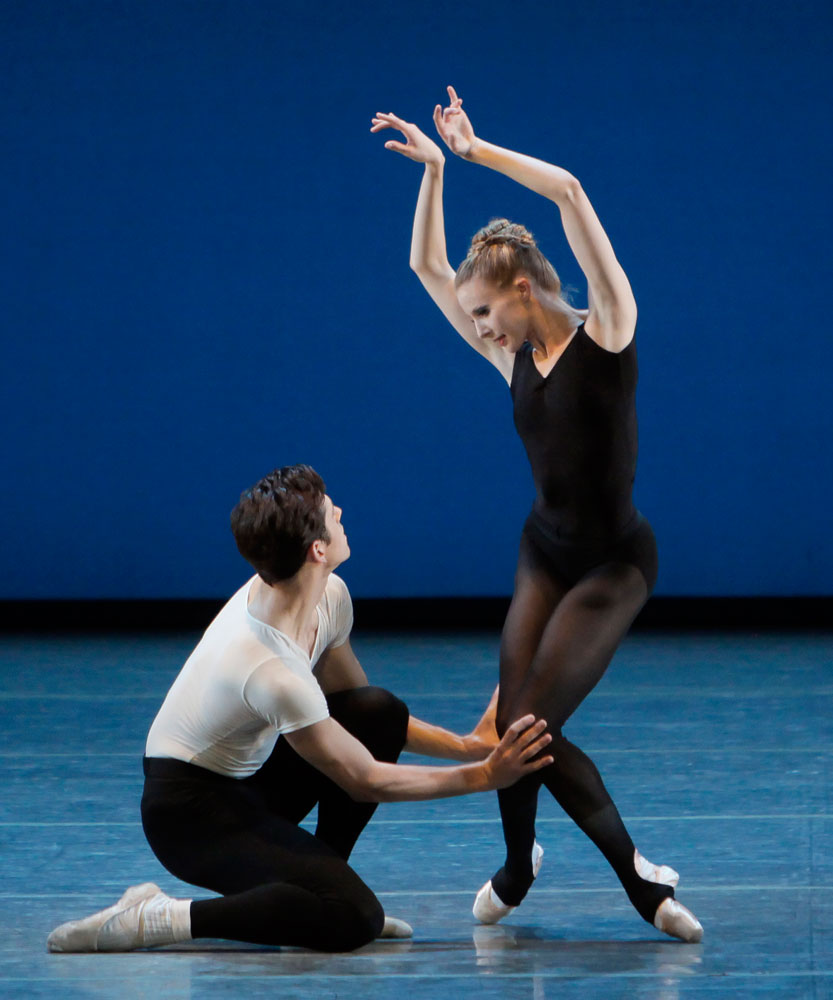
© Paul Kolnik. (Click image for larger version)
Sterling Hyltin, perhaps the company’s most versatile and subtle actress, plays with the subtle shifts of power, her own mood darkening as the pas de deux proceeds. Her stylish approach to the movement heightens the choreography’s twisted, rococo shapes, the jutting hips, the angular knees, the closed positions unfolding into wide-open ones. Kowroski’s impossibly long, lean physique lends the first pas de deux an almost inhuman quality, though she is still regaining her strength after a recent injury. The men, in contrast, shine in the outer sections, giant rollicking ensembles that send squadrons of dancers out in competitive sorties.
The evening had begun with Scènes de Ballet (1999), Christopher Wheeldon’s charming, if overlong, tribute to the School of American Ballet. (The length is Stravinsky’s fault, not Wheeldon’s, but still.) Sixty-two students from the school perform classroom steps within a set by Ian Falconer meant to evoke a ballet studio. The style of the room is a cross between the Paris Opéra and the Bolshoi, with onion domes in the distance. A diagonally-placed barre traverses one side from back to front, with dancers peering at their “reflection” – another miniature dancer – in an imaginary mirror. The kids are great, especially the little ones, so well trained, so exact, and yet still so child-like. A few of the kids are recognizable from Nutcracker performances just last month. Stravinsky created the score for a show starring Alicia Markova and Anton Dolin at the Ziegfeld Theater in 1944; the music is pretty, but anodyne. Stravinsky described it later as “featherweight and sugared.” He was right.

© Paul Kolnik. (Click image for larger version)
Robbins’ The Cage (1951) is a guaranteed crowd pleaser; what could be more thrilling than ballerinas in fright wigs jabbing the stage with their pointes and slicing away at their partners with hands clenched into sharp claws? The ballet is a female revenge fantasy set in an insect colony beneath a spider-web sky. The costumes, leotards with dark stitching reminiscent of entrails and trunks for the men, is striking and theatrical and très Martha Graham. Lauren Lovette, as the newest member of the sisterhood, manages to look gorgeous despite the deliberately grotesque poses, silent screams and choppy wig. Her enormous eyes glisten as she crouches, knees bent, head hunched, staring out with a mix of fear, curiosity and eagerness. The two men who cross her path, Jared Angle and Sean Suozzi, don’t stand a chance. Savannah Lowery, tall, muscular, and wonderfully strong, makes a commanding Queen.
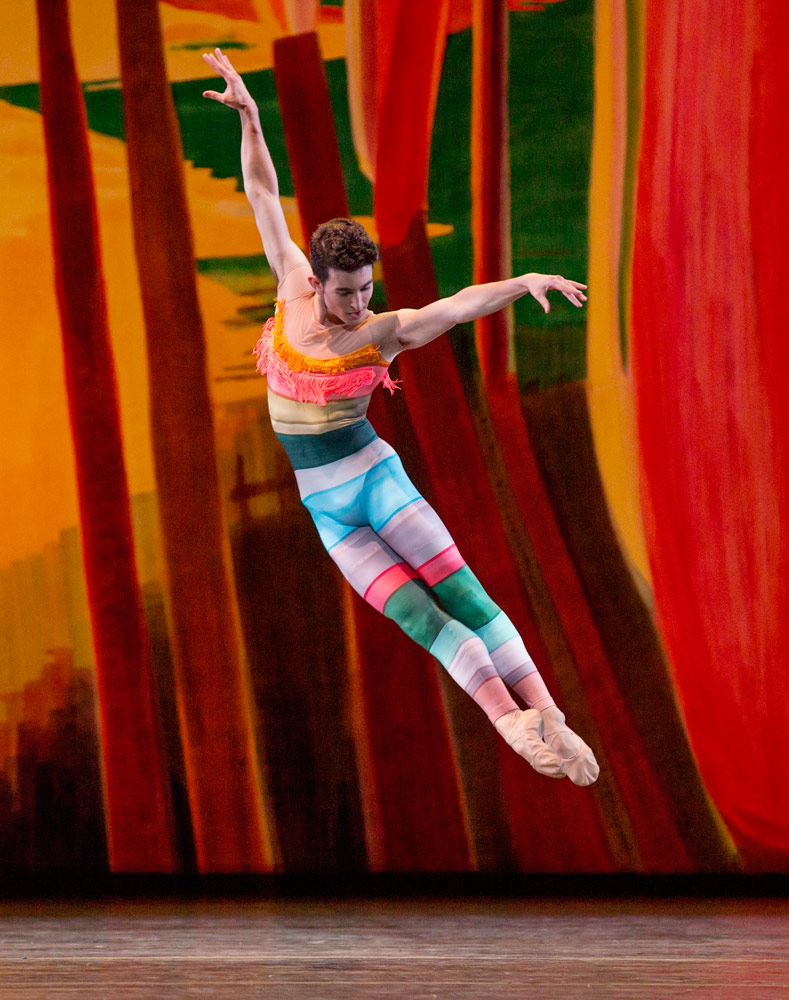
© Paul Kolnik. (Click image for larger version)
The two middle works, Eight Easy Pieces (by Peter Martins) and Scherzo Fantastique (by Justin Peck) prove the slightest. The Martins (1980), set to a suite for four-hand-piano, is danced by three women from the corps. Rachel Hutsell, musical and warm, is the standout. The dances are light: a polka, a little waltz, a Russian dance. The charm is a little forced, though the dancing was lovely. Peck’s Scherzo Fantastique displays the young choreographer’s usual facility. The style is clean, crisp, oblique, streamlined. This is the latest in a spate of upbeat, youthful ballets he has made for the company. There is a bird theme in both the music and the choreography; Anthony Huxley flutters and flits across the stage, accompanied by flutes and woodwinds, barely touching the ground, his arms like wings. He is a marvel, but Peck has visited this territory before. The ballet was made last summer to celebrate City Ballet’s five-decades-long relationship with the Saratoga Performing Arts Center, its summer home; perhaps this is why it feels slight, more like a pièce d’occasion than a statement. The most memorable aspect is the design: bright, sunny streaks of color by the French artist Jules de Balincourt echoed by whimsical striped unitards by Reid Bartelme and Harriet Jung. My favorite detail was the fringe, which trembled and flickered with every move.
All in all, not a bad night at the ballet, although one could argue that five Stravinsky ballets in a row may be one or two too many. That is, until Stravinsky Violin Concerto roars onstage.













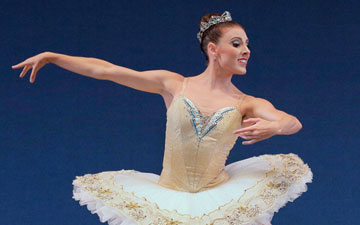
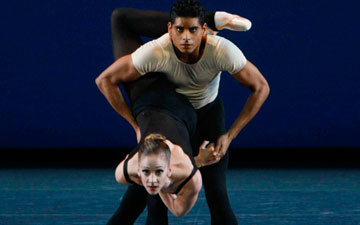
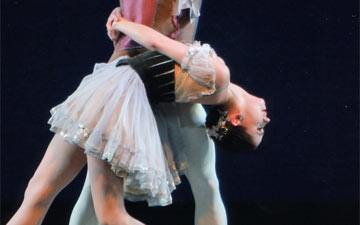
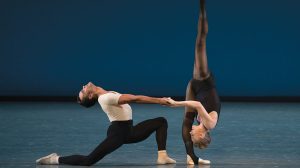
You must be logged in to post a comment.